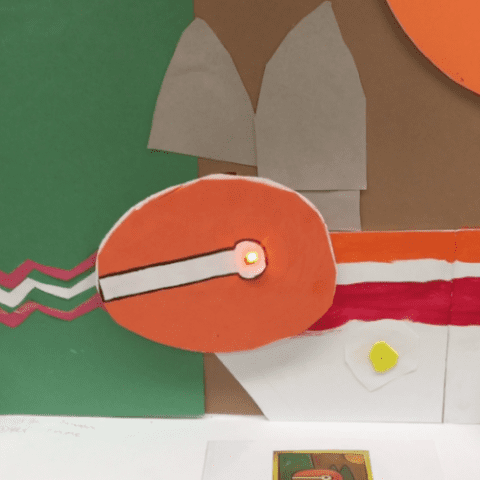Moving Masterpieces
Subjects
World Languages, Art & Music, Language Arts
Project Type
Moving Scenes
Required Tutorials
Position servo, Rotation servo, Single color LED, & Tri-color LED
Estimated Time
Long (6+ hours)
Description
Recreate a painting as a three-dimensional art form.
Teacher Credit
Jayne Sweet of South Allegheny Middle School
Project Map
Learning Goals
- Students will research artists and artworks to choose a painting to replicate.
- Students will recreate a two-dimensional painting as a three-dimensional kinetic art form using various art techniques appropriate to their sculpture.
- Students will add motion and/or light to their creation using the Hummingbird robotics kit.
- Students will defend how they chose to incorporate light and motion based on features of the artwork that they chose.
Materials
- Hummingbird Bit Premium Kit
- Possible Craft supplies
Tips
- Have students work in groups of 2-3.
- Our Printables page has a variety of documents for making teaching and learning with Hummingbird easier. Visit and explore resources like the My First Robot Design Notebook now.
Steps
LESSON PROCEDURES:
This project took place over a nine-week quarter with a class 30 eighth-grade students. Students chose to work by themselves or in groups of 2-3.
- Begin the quarter by asking, “What is art?” Lead students to create a mindmap of their answers and introduce a variety of artwork to encourage them to reflect on this question.
- Explain to students the project requirements, which are listed below.
- Students must choose an artwork. They will be responsible for knowledge of the artist and artwork they choose.
- Students must recreate the artwork in three dimensions.
- They must incorporate light and/or movement into the artwork in a way that is congruent with the goals of the artist.
- Students must present their work to the class and justify how they chose to integrate robotics into the chosen artwork. Students must also prepare an artist statement for their work to justify their design decisions.
- Have students research different artists to choose an artist and artwork for this project. In this case, students chose from a list of 144 artists.
- Introduce students to the Hummingbird using the videos and resources available on the Hummingbird website. Give students time to explore how to use lights and motors with the Hummingbird.
- Have students create a sketch to plan their project. This sketch should show how the project will incorporate light and motion.
- Give students time to complete their projects and artist statements. Students can use foam, cardboard, and craft supplies to construct their projects, as well as repurposed materials such as empty food containers.
- On the last day or two of the project, have each group present their work to the class. You may also want to give students the opportunity to present their work more publicly. For instance, students can set up the projects in a gallery format and invite other teachers or classes to visit.
Standards Alignment
This project was designed to meet Pennsylvania state standards in the arts and humanities; these standards are shown below. This project also meets Common Core ELA standards in speaking and listening (CCRA.SL.1-CCRA.SL.6). Finally, this project is aligned with the middle school engineering standards in the Next Generation Science Standards (MS-ETS1-2 and MS-ETS1-3).
9.1.8.A. Know and use the elements and principles of each art form to create works in the arts and humanities.
9.1.8.B. Recognize, know, use and demonstrate a variety of appropriate arts elements and principles to produce, review and revise original works in the arts.
9.1.8.C. Identify and use comprehensive vocabulary within each of the arts forms.
9.1.8.F. Explain works of other within each art form through performance or exhibition.
9.1.8.H. Demonstrate and maintain materials, equipment and tools safely at work and performance spaces.
9.1.8.J. Incorporate specific uses of traditional and contemporary technologies in furthering knowledge and understanding in the humanities.
9.2.8.A. Explain the historical, cultural and social context of an individual work in the arts.
9.2.8.D. Analyze a work of art from its historical and cultural perspective.
9.2.8.F. Know and apply appropriate vocabulary used between social studies and the arts and humanities.
9.3.8.A. Know and use the critical process of the examination of works in the arts and humanities.
9.4.8.B Compare and contrast informed individual opinions about the meaning of works in the arts to others.





